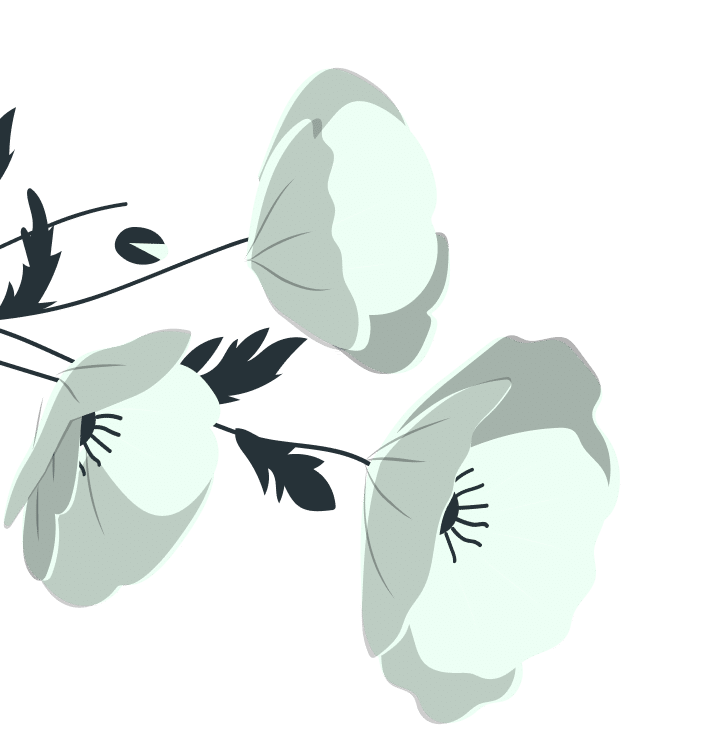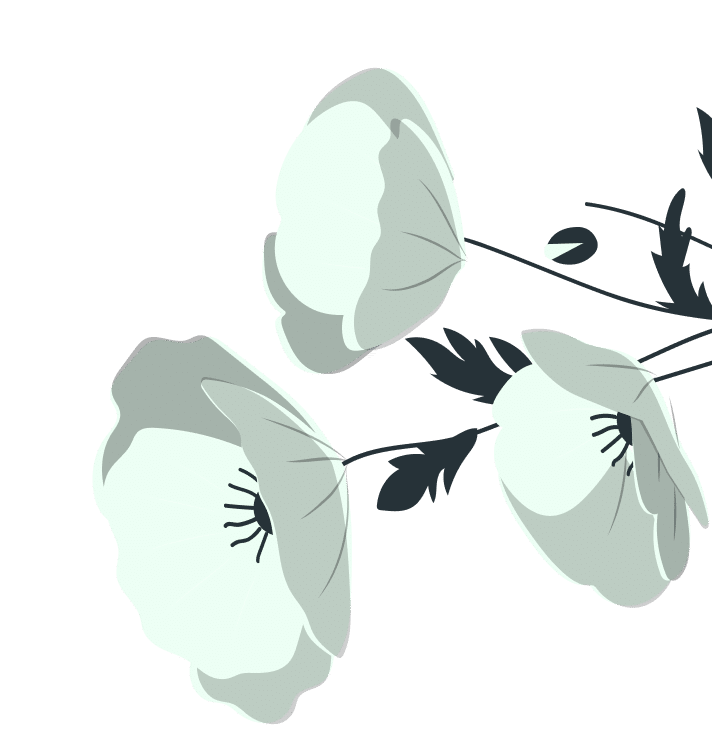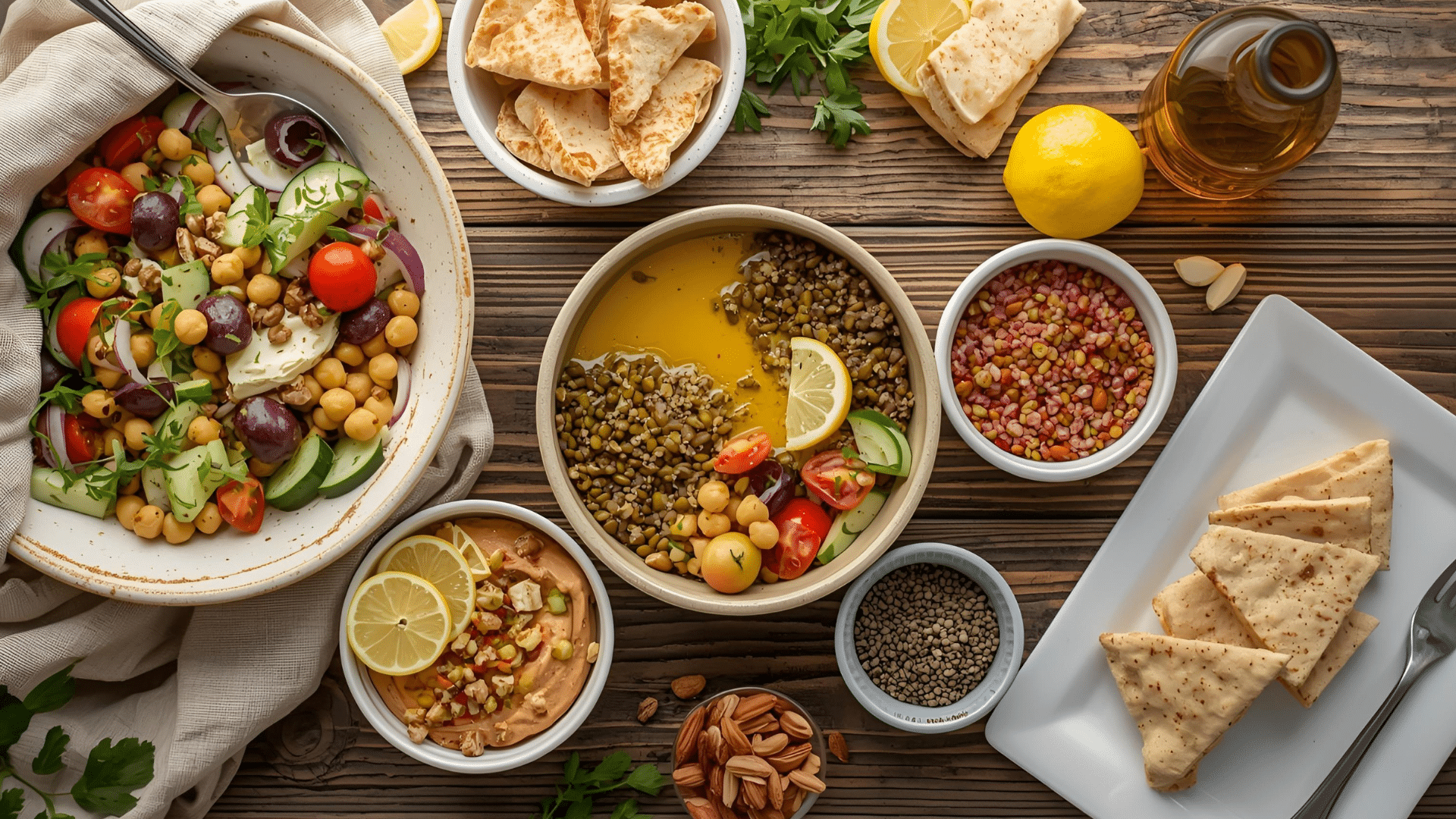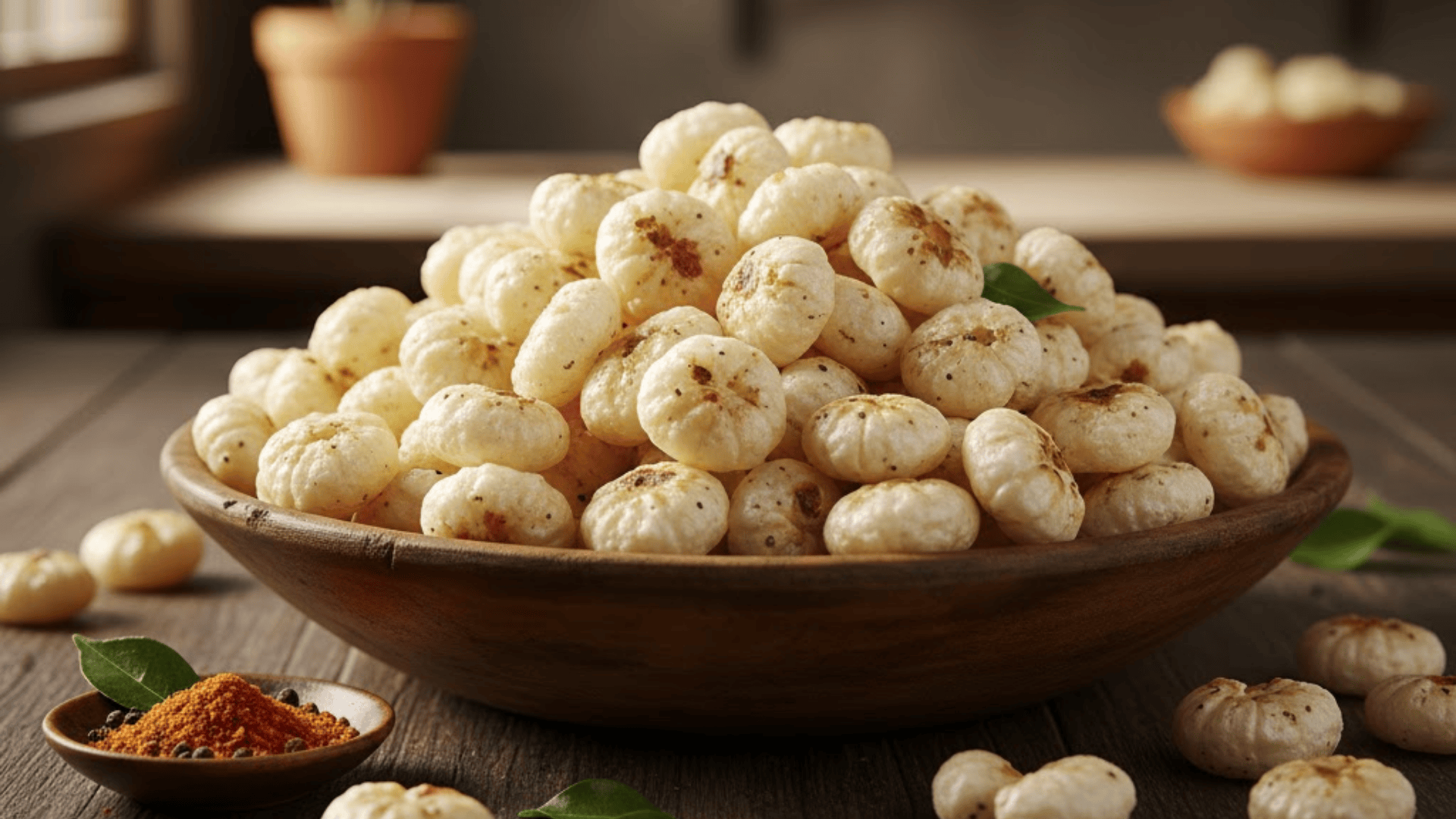My skin kept acting up, and nothing seemed to help until I finally gave herbs a real shot.
If you’re dealing with breakouts, inflammation, or just feel like something’s off inside, learning about manjistha benefits might give you a new place to start.
This root has supported skin, digestion, and hormonal balance for centuries, and it’s still relevant today. With the right approach, it may help your body feel cleaner, lighter, and more in sync.
What is Manjistha?
Manjistha, or Rubia cordifolia, is a climbing plant native to India, long valued in Ayurveda for its support in cleansing and restoring the body.
Often used in traditional skin and blood remedies, it helps remove buildup from the system while soothing inflammation. The plant’s roots contain active compounds like purpurin, alizarin, and manjistin, which help support clear skin and healthy circulation.
Today, it’s still used in herbal powders, oils, and capsules to aid with skin troubles, sluggish digestion, and seasonal body cleansing.
Benefits of Manjistha
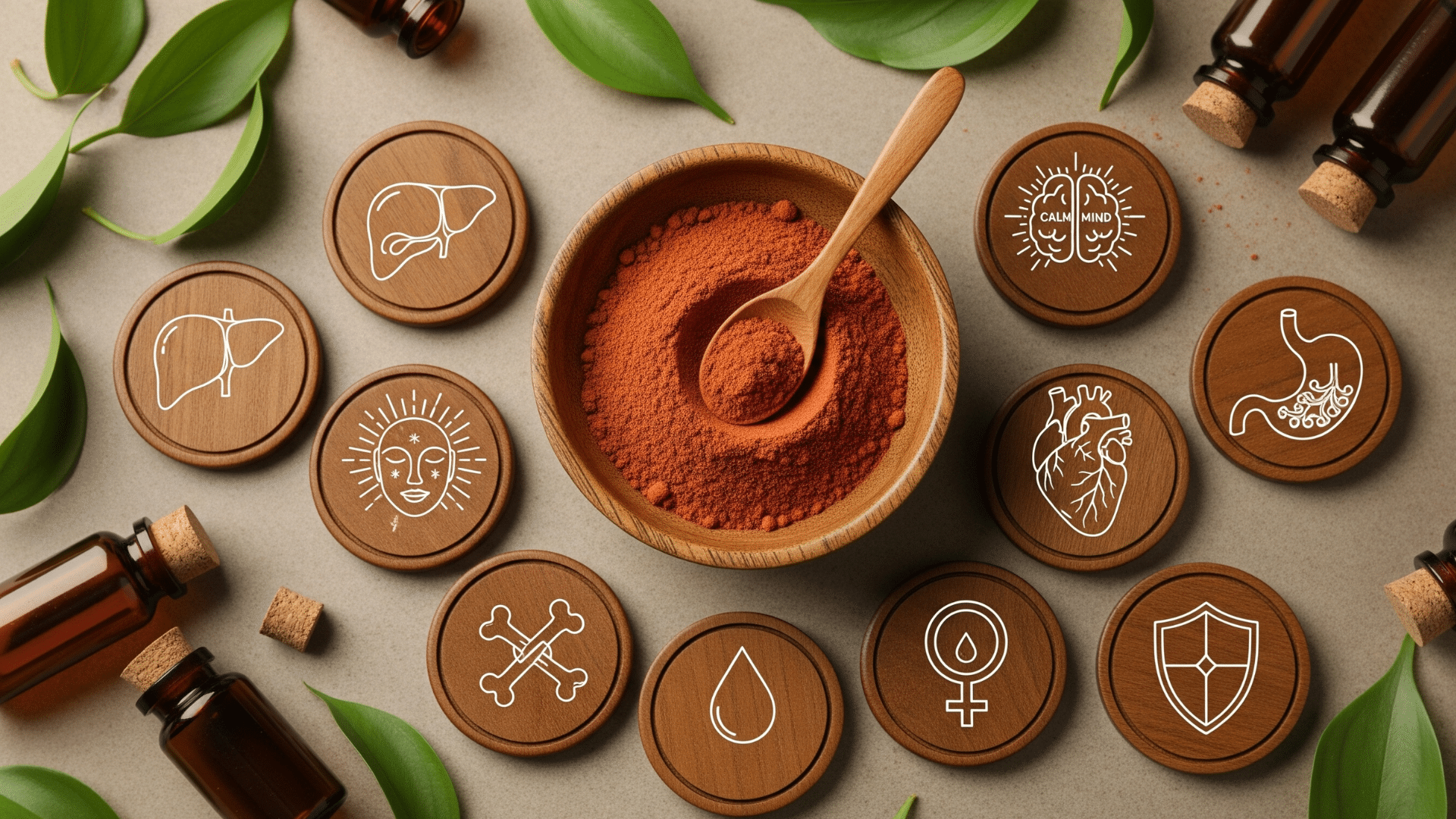

If you’re wondering why I trust Manjistha, let me walk you through its powerful uses; you might find them helpful too.
1. Detoxifies Blood and Lymph
Manjistha helps your body flush out deep-seated waste by cleaning both the blood and lymphatic systems. It supports your liver, filters toxins, and keeps the lymph fluid moving properly.
This makes it easier for your body to get rid of buildup that can lead to tiredness, skin flare-ups, or poor immune response. It’s often used during seasonal changes for mild internal cleansing.
2. Promotes Clear, Glowing Skin
Manjistha has natural properties that help soothe skin irritation, reduce breakouts, and ease redness. It works deep within the skin layers to slow pigmentation, lighten spots, and support healing from issues like eczema or rashes.
Many people turn to it when creams don’t work, especially for acne or dull, uneven skin tone caused by toxins in the blood.
3. Balances Menstrual Health
This herb supports reproductive balance by easing cramps and helping regulate your monthly cycle. It’s beneficial for people dealing with irregular periods, heavy flow, or signs of PCOS.
Manjistha cools excess heat in the system, which can trigger hormonal shifts and body discomfort. Over time, it supports smoother cycles without harsh supplements or synthetic aids.
4. Supports Healthy Joints and Muscles
Manjistha gently lowers swelling in joints and soft tissues, helping reduce stiffness and soreness from daily strain or inflammation. It’s often used by people with arthritis, sports injuries, or chronic discomfort in the knees, hips, or back.
Its cooling effect helps keep pain under control, especially during flare-ups. Long-term use can support smoother joint movement and easier recovery after physical activity.
5. Strengthens Liver and Kidney Function
Manjistha supports both the liver and kidneys, the body’s main detox filters. Its mild diuretic action helps flush out built-up waste through urine, while also reducing the load on the liver.
This dual action makes it great for those feeling bloated, sluggish, or prone to skin issues tied to liver strain. It’s often part of deeper body-reset plans in herbal care.
6. Enhances Digestion and Metabolism
Digestive imbalances often show up on your skin or through low energy. Manjistha supports healthy digestion by improving how your body processes food and absorbs nutrients.
It helps with bloating, heaviness, or slow metabolism that can lead to toxin buildup. It also reduces heat and irritation in the stomach, making it helpful for those with acne tied to gut trouble.
7. Soothes the Nervous System & Lowers Stress
This herb is known for calming heat in the body that shows up as anger, frustration, or mental burnout. Manjistha works on pitta-type imbalances, helping quiet emotional tension and reducing nervous stress.
It gently supports mental clarity and balance without drowsiness or harsh effects. When used over time, it can bring more ease to both the body and mind.
8. Fights Infections with Antimicrobial Power
Manjistha has properties that stop the growth of harmful microbes in your gut, blood, or on the skin. It’s used to treat minor skin infections, recurring breakouts, or signs of imbalance in the stomach caused by bacteria.
Because it works on both surface and internal layers, it helps keep skin clear and gut clean without harsh medication.
9. Acts as a Natural Blood Thinner
By improving blood flow, Manjistha helps prevent sluggish circulation and supports heart health. It has a mild thinning effect, which makes it worthwhile in conditions where blood moves too slowly or clots too easily.
However, anyone taking medications for clotting or heart issues should use them carefully and only under supervision, since combining herbs with drugs can change their effects.
How Manjistha Supports Different Health Conditions
I’ve noticed that Manjistha doesn’t work the same way for everyone. If you’re curious, here’s how it can help in specific situations.
Manjistha for Hormonal Acne (Teens & PCOS)
When breakouts are deep, painful, and won’t calm down, Manjistha can help cool the system from the inside. It clears heat from the blood, balances hormones, and helps move stuck lymph fluid that often causes cystic acne.
Teens or people with PCOS may find it helpful when topical creams stop working. Used regularly, it can ease redness, swelling, and scarring from hormonal acne.
Manjistha for Menopause Support
During menopause, Manjistha helps reduce heat-related symptoms like hot flashes, night sweats, and restlessness. It also supports skin clarity and helps drain fluid from tissues, which can slow puffiness or swelling.
The herb’s natural cooling and purifying action is gentle enough to use over time. You might find it helpful if you’re looking for herbal support that doesn’t throw hormones off balance.
For Athletes and Joint Inflammation
Manjistha supports active people by helping the body manage inflammation after workouts or long physical days. It eases muscle tension, calms joint swelling, and helps reduce reliance on daily pain pills.
Many athletes use it to support quicker recovery from soreness and overuse. If you’re training hard or managing old injuries, this herb might keep your body moving without extra strain.
How to Use Manjistha
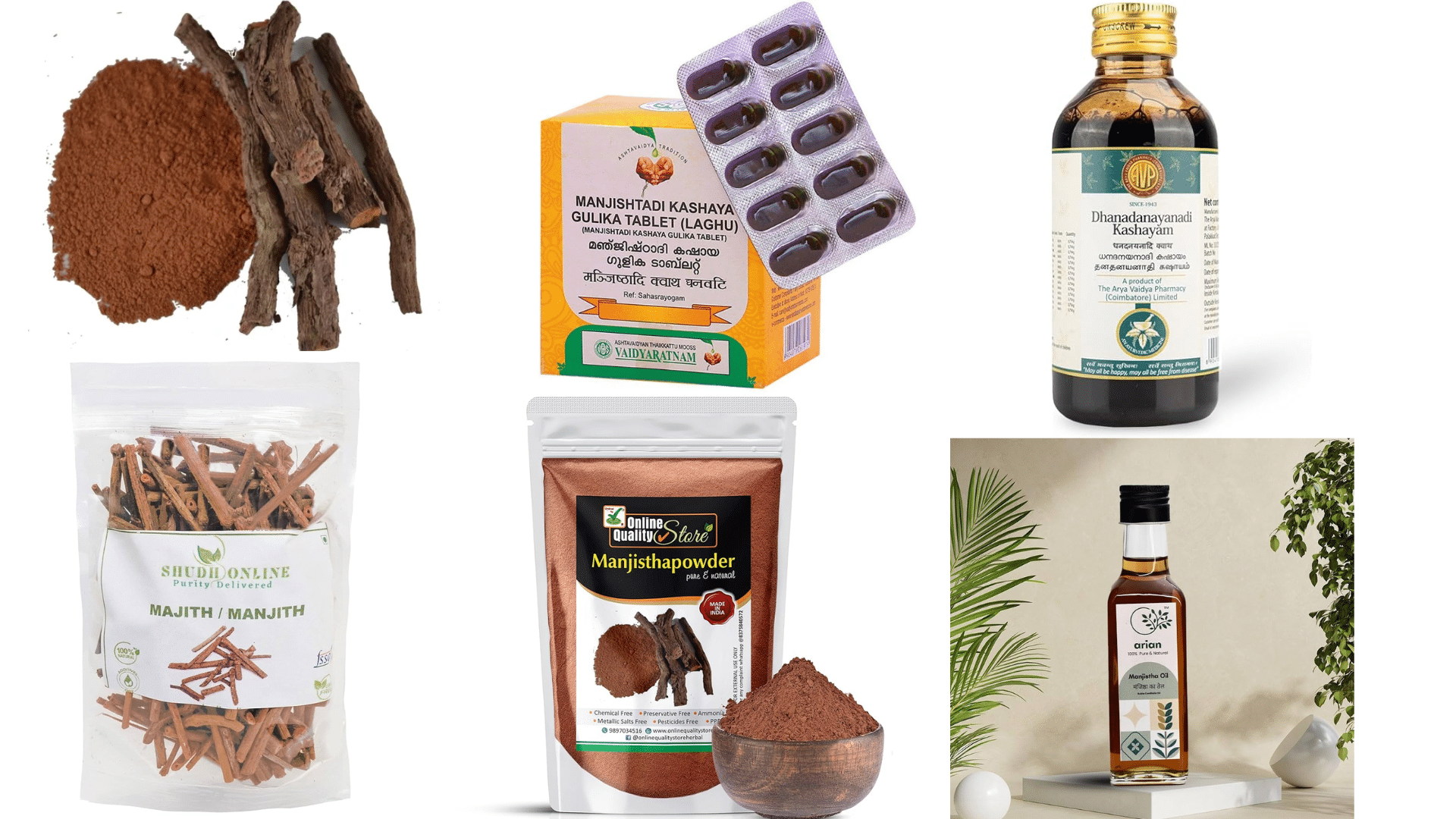

Manjistha can be taken internally or applied externally. The form you choose depends on your goals, tolerance, and condition type.
- Powder (Churna): Mix with warm water or honey. Taken daily to support blood cleansing, digestion, and skin clarity.
- Capsules/Tablets: An easy-to-use form for daily detox. Ideal for people who can’t tolerate bitter herbs or powders.
- Decoction (Kashayam): Boil in water and strain. Traditionally used for deep internal cleansing and addressing long-term skin or menstrual problems.
- Herbal Oil (External): Apply on skin or joints. Helps with acne, pigmentation, swelling, or post-workout soreness. Safe for regular use.
- Oral Use (Internal): Best for detox, digestion, menstrual balance, or skin health. Works slowly and deeply when taken consistently.
- Topical Use (External): Use as a paste or oil. Helps calm localized issues like acne, rashes, swelling, or dark spots.
Choose the method that suits your needs. When appropriately used, Manjistha supports healing without relying on strong or synthetic solutions.
DIY Skincare With Manjistha
Manjistha isn’t just for internal detox; it also works well in skincare routines. You can use it in simple homemade face masks to support clear, balanced skin. These blends are easy to mix and rely on ingredients you probably already have at home:
For Acne: Mix Manjistha powder with rose water and honey. Apply to clean skin and rinse after 15 minutes.
For Pigmentation: Combine Manjistha with aloe vera gel. Smooth it over dark areas to help fade uneven tone with regular use.
For Dark Spots: Mix Manjistha with plain yogurt and a pinch of turmeric (optional). Helps brighten skin and soften stubborn marks.
Use these 2–3 times per week. Always do a patch test first if your skin is sensitive.
Myth vs. Fact About Manjistha
I know it’s easy to assume natural means safe, but you and I both need to check the facts first.
| Myth | Fact |
|---|---|
| Natural herbs are always safe | Herbs can interact with medications and conditions. |
| More Manjistha = faster detox | Overuse may stress the liver or kidneys. |
| Safe during pregnancy | Not advised unless prescribed by an Ayurvedic doctor. |
So if you’re using Manjistha, you and I both need to stay mindful of the dose, timing, and your body’s needs.
How Much Manjistha You Should Take and When to Use It
If you’re not sure how to use it, here’s how I usually recommend the dose and timing for you
General Guidelines
If you’re using powder, 1–3 grams once a day is typical. For capsules, 250 to 500 mg is usually taken once or twice a day. I suggest starting with the lower dose to check your body’s response.
It’s best taken after meals with warm water or honey to support smooth digestion and better absorption. Avoid cold drinks or raw food right after taking it.
Usage by Goal
For detox or skin clearing, I usually recommend a 4 to 8-week cycle, then take a break. If you’re just maintaining good skin or hormone balance, 2 to 3 times per week is often enough.
You don’t need to take it daily forever. Listen to your body; if you feel dry or tired, reduce the dose or take a short pause. That keeps it safe and effective.
Manjistha vs Other Detox Herbs
If you’re unsure how Manjistha compares, I’ve lined it up with a few herbs I’m frequently asked about.
| Herb | Key Benefit | Best Use |
|---|---|---|
| Manjistha | Blood & skin detox | Acne, menstrual imbalance, pigmentation |
| Neem | Antibacterial | Acne, boils, skin infections |
| Guduchi | Immunity + Fever | Fever, chronic fatigue, and inflammation |
Now that you’ve seen how it compares, you and I can decide what fits your health needs best. Keep it simple.
Who Should Avoid Manjistha?
While Manjistha is gentle, it’s not suitable for everyone. You should always check first if any of these apply to you:
- Pregnant or breastfeeding individuals: Manjistha may affect hormonal balance and should be avoided unless approved by a qualified practitioner.
- People on blood thinners: It has natural thinning effects and could increase the risk of bleeding when combined with medication.
- Those with dehydrated skin or constipation: Its cooling nature may aggravate dryness if not balanced with warming foods or herbs.
- Low blood pressure cases: It may lower pressure slightly, so use caution if you already feel weak, dizzy, or lightheaded often.
- Children under 12: Not recommended without professional supervision due to limited research and the body’s different detox capacity at that age.
Conclusion
Now that you’ve seen how Manjistha supports your skin, hormones, joints, and overall detox, I hope it feels more approachable.
If you’re thinking about trying it, start small and notice how your body responds; it doesn’t have to be all or nothing. I’ve found that slow, steady use makes a big difference.
Just stay consistent and listen to your needs. There’s a lot more to learn when it comes to herbal health.
Want to keep building your routine? Check out my other guides to better understand how herbs’ benefits fit with your wellness goals.
